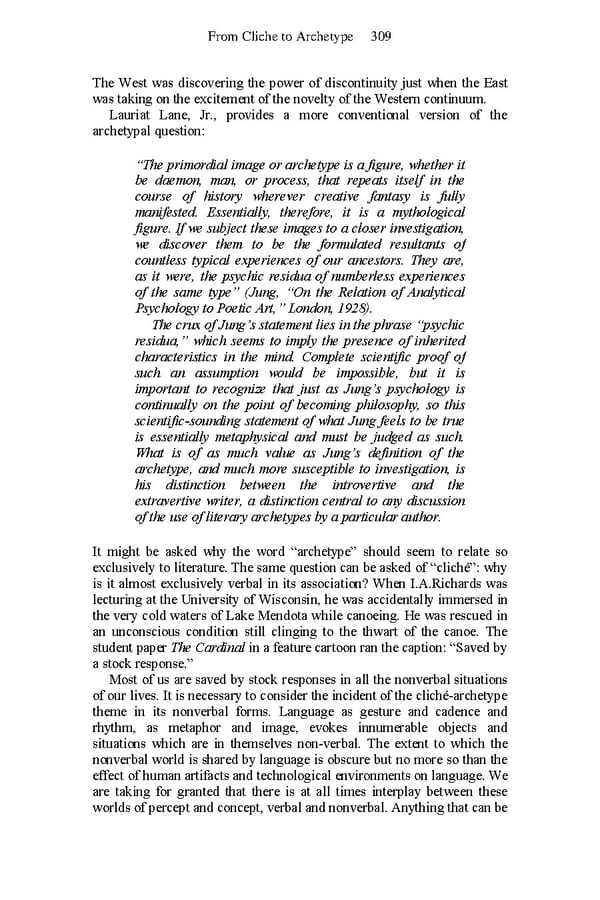From Cliche to Archetype 309 The West was discovering the power of discontinuity just when the East was taking on the excitement of the novelty of the Western continuum. Lauriat Lane, Jr., provides a more conventional version of the archetypal question: “The primordial image or archetype is a figure, whether it be daemon, man, or process, that repeats itself in the course of history wherever creative fantasy is fully manifested. Essentially, therefore, it is a mythological figure. If we subject these images to a closer investigation, we discover them to be the formulated resultants of countless typical experiences of our ancestors. They are, as it were, the psychic residua of numberless experiences of the same type” (Jung, “On the Relation of Analytical Psychology to Poetic Art,” London, 1928). The crux of Jung’s statement lies in the phrase “psychic residua,” which seems to imply the presence of inherited characteristics in the mind. Complete scientific proof of such an assumption would be impossible, but it is important to recognize that just as Jung’s psychology is continually on the point of becoming philosophy, so this scientific-sounding statement of what Jung feels to be true is essentially metaphysical and must be judged as such. What is of as much value as Jung’s definition of the archetype, and much more susceptible to investigation, is his distinction between the introvertive and the extravertive writer, a distinction central to any discussion of the use of literary archetypes by a particular author. It might be asked why the word “archetype” should seem to relate so exclusively to literature. The same question can be asked of “cliché”: why is it almost exclusively verbal in its association? When I.A.Richards was lecturing at the University of Wisconsin, he was accidentally immersed in the very cold waters of Lake Mendota while canoeing. He was rescued in an unconscious condition still clinging to the thwart of the canoe. The student paper The Cardinal in a feature cartoon ran the caption: “Saved by a stock response.” Most of us are saved by stock responses in all the nonverbal situations of our lives. It is necessary to consider the incident of the cliché-archetype theme in its nonverbal forms. Language as gesture and cadence and rhythm, as metaphor and image, evokes innumerable objects and situations which are in themselves non-verbal. The extent to which the nonverbal world is shared by language is obscure but no more so than the effect of human artifacts and technological environments on language. We are taking for granted that there is at all times interplay between these worlds of percept and concept, verbal and nonverbal. Anything that can be
 Essential McLuhan Page 315 Page 317
Essential McLuhan Page 315 Page 317